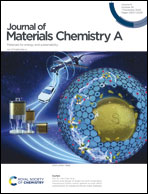Synthetic polymers based on lignin-derived aromatic monomers for high-performance energy-storage materials†
Abstract
Lignin, a renewable and low-cost biopolymer, has been widely reported as an energy-storage material. The energy-storage capability of lignin primarily originates from the redox of its internal quinone group. Hence, effective optimization of the lignin structure is of great significance for increasing the quinone group content, which is vital for improving the energy-storage performance of lignin-based electrode materials. Herein, synthetic polymers (SPs) with an extremely high quinone group content were prepared using lignin-derived aromatic monomers (LDAMs) as precursors. The chemical structure of the SP samples was analyzed using 13C and 31P NMR, and the results showed that their quinone content was as high as 5.49–6.75 mmol g−1, which is 6–7 times higher than that of commercial kraft lignin (KL). The RGO/SP composite was prepared using ultrasound-assisted self-assembly, and as expected, the SP coupled with reduced graphene oxide acquired a high specific capacitance of 352–465 F g−1, which is 1.4–1.9 times higher than that of RGO/KL. In addition, the RGO/SP electrodes showed an excellent rate performance of 265–365 F g−1 at 10 A g−1. Overall, our strategy provides a possibility for the preparation of high-performance lignin-based energy-storage materials.



 Please wait while we load your content...
Please wait while we load your content...